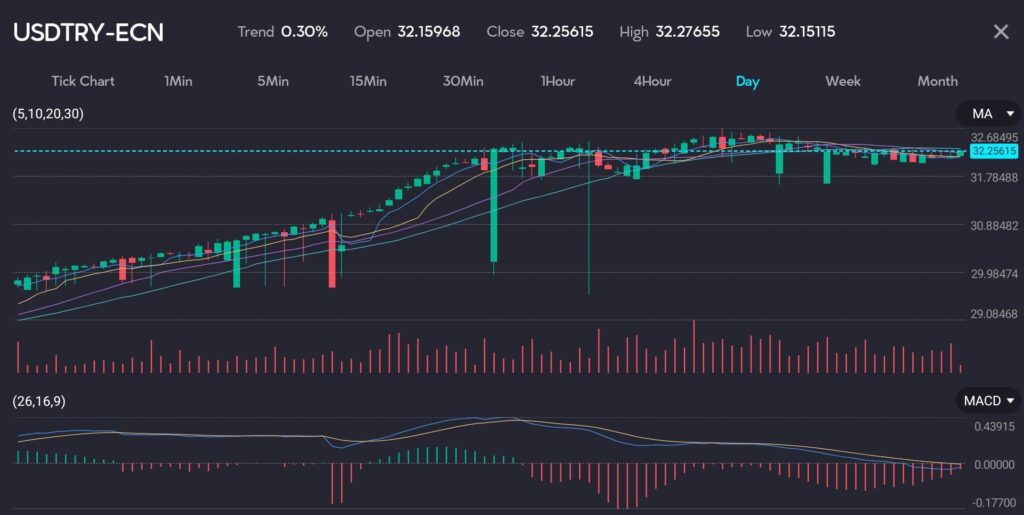Key Points:
- The Central Bank of Turkey (CBT) kept the policy rate at 50%, in line with expectations.
- CBT maintains a tightening bias, indicating further hikes may be necessary if inflation persists.
- Forex reserves have improved, leading to increased Turkish Lira (TRY) liquidity and new measures to control excess liquidity.
On Thursday, the Central Bank of Turkey (CBT) decided to keep its policy rate unchanged at 50%, consistent with market expectations. Such decision was made to address ongoing concerns about inflation, which continues to pose a significant risk to the Turkish economy.
In its policy statement, the CBT cited the lagged effects of previous monetary tightening but notably dropped the reference to “a significant tightening in financial conditions.” The central bank maintained its tightening bias, leaving the door open for further rate hikes if inflationary pressures persist.
The forward guidance was unchanged, with the CBT pledging to keep the policy rate at its current level as long as necessary.
Turkish CPI and inflation expectations
In the inflation report published in early May, the CBT raised its 2024 consumer price index (CPI) inflation forecast to 38.0% while keeping the 2025 forecast at 14.0%.
Market expectations for 2024 and 2025 have declined to 43.6% and 25.6%, respectively, while expectations for the next 12 and 24 months have improved to 33.2% and 21.3%.
Tying these data with real life, the CBT’s Monetary Policy Committee (MPC) noted that domestic demand has slowed, but imports of consumption goods remain high.
Since early April, expectations for tight post-election policies have increased forex supply, and in turn also increased TRY liquidity. To manage such excess liquidity, CBT took a few measures, including raised reserve requirements on the TRY among others.
Domestic loan deceleration
TRY loan growth has decelerated due to the tightening rates and monthly growth caps, while forex lending has continued to gain momentum, recording an increase of over $15 billion year-to-date. Such growth presents risks to the effectiveness of the monetary transmission mechanism and leads to gradual currency risk accumulation in the corporate sector.
To mitigate these risks, the CBT extended the 2% monthly growth cap on TRY loans to forex loans and decided that for loans exceeding the limit, banks would hold TRY-denominated required reserves for one year. This move is expected to further moderate banking sector credit growth in the coming period.
What should Turkish Lira currency traders do in May?
The CBT is likely to maintain a tight monetary policy to combat inflation. With that, inflation may stabilise within the forecast range of CBT if the current policies are effective. However, the risks of forex lending and domestic demand fluctuations remain.
Potential rate cuts may be considered by late 2024 if inflation shows a significant and sustained decline and inflation expectations align with CBT forecasts.

SEE: The USD/TRY pair experiences upswing in the VT Markets trading app.
In light of this news, the USD/TRY currency pair has been experiencing a general uptrend, evident from the pattern of higher highs and higher lows in the daily chart. Recently, the price closed at 32.25615, slightly up from the opening price of 32.15968, marking a 0.30% increase for the day.
This positive movement, however, comes with some consolidation around the 32.25 level after a series of upward movements.
Technical analysis for USD/TRY
The moving averages on the chart, which provide dynamic support and resistance, show that the price remains above most of these averages, suggesting continued bullish sentiment. Trading volume spikes, especially on days with larger candlesticks, indicate increased market interest and activity in the currency pair.
The MACD (Moving Average Convergence Divergence) indicator at the bottom shows a series of red bars, indicating recent bearish momentum. However, the MACD line is nearing a potential bullish crossover with the signal line, which could signal a continuation of the upward trend if it occurs.
However, considering Turkey’s intention to introduce hawkish measures, such as raising interest rates or tightening monetary policy, this could strengthen the Lira. Hawkish measures typically aim to combat inflation and stabilise the currency, potentially reversing some of the USD/TRY pair’s upward momentum.
If Turkey implements these measures effectively, it could lead to a decrease in the USD/TRY exchange rate as the TRY strengthens against the USD. This potential shift could disrupt the current uptrend and lead to a more bearish outlook for the pair.
All of these present trading opportunities for exotic currency pairs, such as USDTRY and EURTRY, provided if a good trading strategy is followed and risk management is practiced with discipline.







